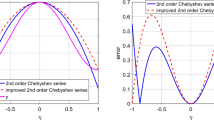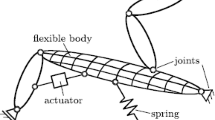Abstract
The classical natural coordinate modeling method which removes the Euler angles and Euler parameters from the governing equations is particularly suitable for the sensitivity analysis and optimization of multibody systems. However, the formulation has so many principles in choosing the generalized coordinates that it hinders the implementation of modeling automation. A first order direct sensitivity analysis approach to multibody systems formulated with novel natural coordinates is presented. Firstly, a new selection method for natural coordinate is developed. The method introduces 12 coordinates to describe the position and orientation of a spatial object. On the basis of the proposed natural coordinates, rigid constraint conditions, the basic constraint elements as well as the initial conditions for the governing equations are derived. Considering the characteristics of the governing equations, the newly proposed generalized-α integration method is used and the corresponding algorithm flowchart is discussed. The objective function, the detailed analysis process of first order direct sensitivity analysis and related solving strategy are provided based on the previous modeling system. Finally, in order to verify the validity and accuracy of the method presented, the sensitivity analysis of a planar spinner-slider mechanism and a spatial crank-slider mechanism are conducted. The test results agree well with that of the finite difference method, and the maximum absolute deviation of the results is less than 3%. The proposed approach is not only convenient for automatic modeling, but also helpful for the reduction of the complexity of sensitivity analysis, which provides a practical and effective way to obtain sensitivity for the optimization problems of multibody systems.
Similar content being viewed by others
References
HAUG E J, WEHAGE R, BARMAN N C. Design sensitivity analysis of planar mechanism and machine dynamics[J]. Transactions of the ASME, 1981, 103(3):560–570.
HAUG E J, MANI N K. Design sensitivity analysis and optimization of dynamically driven systems[C]//Computer Aided Analysis and Optimization of Mechanical System Dynamics, Germany: Springer Berlin Heidelberg, 1984: 555–636.
SERBAN R, HAUG E J. Kinematic and kinetics derivatives for multibody system analyses[J]. Mech. Struct. Mach, 1998, 26(2):145–173.
DING Jieyu, PAN Zhenkuan, CHEN Liqun. Adjiont variable method for sensitivity analysis of multibody system dynamics described by differential/algebraic equations[J]. Journal of Dynamics and Control, 2006, 4(3): 205–209. (in Chinese)
DING Jieyu, PAN Zhenkuan, CHEN Liqun. Adjoint variable method for design sensitivity analysis of multibody system dynamics described by ordinary differential equations[J]. Engineering Mechanics, 2006, 23(2): 56–59. (in Chinese)
WANG X, HAUG E J, PAN W. Implicit numerical integration for design sensitivity analysis of rigid multibody systems[J]. Mechanics Based Design of Structures and Machines, 2005, 33(1):1–30.
GARCÍA J, BAYO E. Kinematics and dynamic simulation of multibody systems: The real-time challenge[M]. New York: Springer, 1993.
GARCÍA J. Twenty-five years of natural coordinates[J]. Multibody System Dynamics, 2007, 18(1):15–33.
ÁLVAREZ G, GUTIÉRREZ A, SERRANO N, et al. Computer data acquisition, analysis and visualization of elite athletes motion[C]// International Society of Biomechanics. Technical Group on Computer Simulation. Symposium on Computer Simulation in Biomechanics, Montlignon, Paris, France, June 30–July 2, 1993. Paris: International Society of Biomechanics, 1993:85–97.
CELIGÜETA J T. Multibody simulation of human body motion in sports[C]//International Society of Biomechanics in Sports. Symposium on Biomechanics in Sports FMH, Madeira, Portugal, June 25–29, 1996. Portugal: Technical University of Lisbon, 1996:81–94.
AUSEJO S, SUESCUN Á, CELIGÜETA J. An optimization method for overdetermined kinematic problems formulated with natural coordinates[J]. Multibody System Dynamics, 2011, 26(4):397–410.
KRAUS C, BOCK H G, MUTSCHLER H. Parameter Estimation for Biomechanical Models Based on a Special Form of Natural Coordinates[J]. Multibody System Dynamics, 2005, 13(1):101–111.
SILVA M P T, AMBRÓSIO J A C. Sensitivity of the results produced by the inverse dynamic analysis of a human stride to perturbed input data[J]. Gait and Posture, 2004, 19(1):35–49.
SERBAN R, FREEMAN J S. Identification and identifiability of unknown parameters in multibody dynamic systems[J]. Multibody System Dynamics, 2001, 5(4):335–350.
BESTLE D, EBERHARD P. Analyzing and optimizing multibody systems[J]. Mechanics of Structures and Machines, 1992, 20(1):67–92.
BESTLE D, SEYBOLD J. Sensitivity analysis of constrained multibody systems[J]. Archive of Applied Mechanics, 1992, 62(3):181–190.
BISCHOF C H. On the automatic differentiation of computer programs and an application to multibody systems[C]//The International Union of Theoretical and Applied Mechanics. The IUTAM Symposium on Optimization of Mechanical Systems, Stuttgart, Germany, March 26–31, 1995. Dordrecht: Kluwer Academic, 1996:41–48.
CAMPBELL S L, HOLLENBECK R. Automatic differentiation and implicit differential equations[C]// Society for Industrial and Applied Mathematics. ACM Special Interest Group on Numerical Mathematics(SIGNUM). The Second International Workshop of Computational Differentiation, Santa Fe, New Mexico, USA, February 12–15, 1996. Pennsylvania: SIAM, 1996:319–328.
BHALERAO K D, POURSINA M, ANDERSON K S. An efficient direct differentiation approach for sensitivity analysis of flexible multibody systems[J]. Multibody System Dynamics, 2010, 23(3):121–140.
DING Jieyu, PAN Zhenkuan, CHEN Liqun. Second order adjoint sensitivity analysis of multibody systems described by differential-algebraic equations[J]. Multibody System Dynamics, 2007, 18(4):599–617.
DING Jieyu, PAN Zhenkuan, CHEN Liqun. Parameter identification of multibody systems based on second order sensitivity analysis[J]. International Journal of Non-Linear Mechanics, 2012, 47(10):1105–1110.
BAUCHAU O A, LAULUSA A. Review of contemporary approaches for constraint enforcement in multibody Systems[J]. J. Comput. Nonlinear Dyn, 2008, 3(1):90–98.
YAO Tingqiang, CHI Yilin, HUANG Yayu. New generalized-α algorithms for multibody dynamics[J]. Journal of Mechanical Engineering, 2009, 45(10):53–60.
ARNOLD M, BRÜLS O. Convergence of the generalized-α scheme for constrained mechanical systems[J]. Multibody System Dynamics, 2007, 18(2):185–202.
CHUNG J, HULBERT G. A time integration algorithm for structural dynamics with improved numerical dissipation: The generalized-a method[J]. ASME Journal of Applied Mechanics, 1993, 60(4):371–375.
HAUG E J. Computer aided kinematics and dynamics of mechanical systems[M]. Massachusetts: Allyn and Bacon, 1989.
Author information
Authors and Affiliations
Corresponding author
Additional information
This project is supported by National Defense Pre-research Foundation of China during the 12th Five-Year Plan Period(Grant No. 51036050107)
LI Xiufeng, born in 1987, is currently a doctor candidate at State Key Laboratory of Electromechanical Dynamic Control, School of Mechatronical Engineering, Beijing Institute of Technology, China. He received his master degree from Beijing Institute of Technology, China, in 2010. His research interests include virtual prototyping and computer aided engineering.
WANG Yabin, born in 1977, is currently an associate professor at Beijing Institute of Technology, China. He received his PhD degree from Beijing Institute of Technology, China, in 2006. His research interests include mechanical engineering, virtual prototyping and digital design of mechatronical systems.
Rights and permissions
About this article
Cite this article
Li, X., Wang, Y. Sensitivity analysis approach to multibody systems described by natural coordinates. Chin. J. Mech. Eng. 27, 402–410 (2014). https://doi.org/10.3901/CJME.2014.02.402
Received:
Revised:
Accepted:
Published:
Issue Date:
DOI: https://doi.org/10.3901/CJME.2014.02.402




